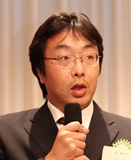Activities of PCAT (Primary Care for All Team) and Challenges to Overcome for the Reconstruction of Tohoku
August 24, 2011
Mr. Kentaro Hayashi
Japan Primary Care Association, Disaster Relief Project for the Great East Japan Earthquake (PCAT��
Chief Coordinator, Former Rotary Scholar
Emergency Medical Doctor
 ��I was born in Sakata City, Yamagata Prefecture, but grew up in Tokyo. I was a resident anesthetist at University of the Ryukyus and later studied emergency care at Nippon Medical School. I joined ��Medecins Sans Frontieres�� in 2004 and offered medical services in Myanmar, Sri Lanka, Nigeria and Iraq.
��I was born in Sakata City, Yamagata Prefecture, but grew up in Tokyo. I was a resident anesthetist at University of the Ryukyus and later studied emergency care at Nippon Medical School. I joined ��Medecins Sans Frontieres�� in 2004 and offered medical services in Myanmar, Sri Lanka, Nigeria and Iraq.
��As a Rotary scholar, I studied tropical medicines and development studies at Royal Tropical Institute in Netherlands in 2007. I further studied disaster medical care in Germany and humanitarian medical care in Denmark and came back to Japan in 2009, after completing my Master��s degree in International Health.
Deadly cyclone Nargis hit Myanmar in 2008 and triggered 15-meter-high storm tides that caused 140,000 fatalities. I joined the relief operation and gave immediate trainings to local interns on tropical and disaster medical care, who were then dispatched to mobile clinics in disaster areas. I also assisted disaster orphans as well as local physicians and hospitals towards reconstruction.
��In cases of massive disaster, medical staff triages patients into either ��green, yellow, red or black�� categories, based on the severity of their conditions and prepare for ambulance transport. Medical teams dispatched to rescue emergency patients of the Great East Japan Earthquake on March 11th could not reach disaster areas even after the first critical 72 hours.
��Damages caused by the tsunami hampered immediate access and treatment, thus we found fewer patients categorized ��red (viable victims with potentially life threatening conditions)�� or ��yellow (victims with no life-threatening injuries, but urgently require treatment),�� while most of them were either ��green (victims with minor injuries)�� or ��black (victims who are dead, or whose injuries make survival unlikely).��
��We must provide mid-and-long term assistance during the ��sub-acute�� phase, where reconstruction plays the key role. Such assistance must be locally-based to cater for the individual needs of the victim.
��As I am a member of several disaster assistance organizations, I was given a chance to join PCAT (Primary Care for All Team), the disaster relief project implemented by the Japan Primary Care Association (JPCA). This Association consists of primary-care professionals who serve as family doctors in communities or generalists in hospitals to support patients holistically.
Primary care involves ��the widest scope of health care provided by physicians acting as the principal point of consultation.�� The spirit of ��Primary Care for All�� was advocated by the WHO in the 1970s, and stipulated in the Declaration of Alma-Ata.
��During the relief operation in Myanmar, I realized anew the need for ��all-round medical services�� provided by general practitioners. Fundamental knowledge on public health or preventive medicine against infectious diseases are required. Primary care can also play a pivotal role in community building among evacuation centers and temporary dwellings.
��PCAT members offered medical services at K-wave (the gymnasium) in Kesennuma for the night shift (from 3:00pm to 9:00am the following morning) to 2,000 evacuees. Physicians dispatched from the Japan Medical Association were on duty during the daytime. We isolated flu patients from other evacuees during nighttime. I detected that the poor hygienic condition of temporary lavatories was causing the spread of diarrhea, which developed into dehydration. I called upon junior and senior high school students in good condition to help cleaning the latrines.
��The 10-day-relief activities from March 19th taught me the requirements of emergency medical services, which could be summarized in three points:
1) Bottom-up approach of medical services which respect the local culture and local people.
2) Team of medical personnel with wide-ranging expertise to provide holistic medical assistance that responds to various needs.
3) Provide scholarly medical health assistance by keeping records and prepare for future disasters.
��We have dispatched 300 physicians as well as 300 ��multiple vocational members,�� comprising of dentists, physiotherapists, nurses, midwives, pharmacists and nutritionists. PCAT has offered public health assistance to earthquake survivors at evacuation centers and homes as well as handicapped people who require special needs. We have also assisted damaged medical facilities for continuous operation. I have conducted medical examinations of evacuees from areas around Fukushima nuclear power plants.
��Quake-hit areas had suffered from medical service shortages even before the earthquake, thus greater scale and scope of assistance is needed. I am determined to keep working on the government and medical organizations.
Home medical care at temporary dwellings has already started, and we need to implement home visits by physicians, as most of the evacuees have lost their means of transportation.
��Assistance to the obstetrics and gynecology department is also crucial, as only three delivery facilities remain today out of the seven, which overburdens the scarce resources.
Mental care must be provided to relief personnel, including local medical staff, policemen and administrative officers, who have devoted themselves tirelessly for the past 6 months while suffering from traumatic experience.
Many challenges will await us as we move ahead, yet I am determined to do my best as the PCAT member.